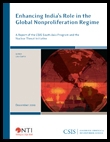A report by Teresita C. Schaffer for the Center for Strategic & International Studies’ Global Health Policy Center.
This report assesses the impact of U.S. engagement with India’s health sector in the past six decades. The United States’ involvement with health in independent India goes back to the earliest days. The longest involvement is through the U.S. foreign aid program, which has worked primarily with the government of India. Other parts of the United States government have also been involved, chiefly the Centers for Disease Control and Prevention (CDC) and both the capacity-building and research activities of the National Institutes of Health (NIH). Private American institutions have been involved in India, including foundations, universities, and medically oriented businesses, as well as private Americans, including many of Indian origin. In at least one case, the recently founded Public Health Foundation of India (PHFI), both the American institution represent public-private collaboration.
Originally published by CSIS in November 2010. Read the entire report.


